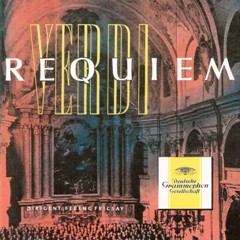111 Years of Deutsche Grammophon - CD 16
111 Years of Deutsche Grammophon - CD 16
Verdi: Requiem

Messa da Requiem 1 1. Requiem [8:22] 2 2. Dies irae [2:05] 3 2. Tuba mirum [2:44] 4 2. Liber scriptus [4:54] 5 2. Quid sum miser [3:36] 6 2. Rex tremendae [3:40] 7 2. Recordare [3:39] 8 2. Ingemisco [3:14] 9 2. Confutatis [4:34] 10 2. Lacrymosa [5:22] 11 3. Offertorium [8:53] 12 4. Sanctus [2:28] 13 5. Agnus Dei [4:22] 14 6. Lux aeterna [5:26] 15 7. Libera me [12:08] Maria Stader – soprano Marianna Radev - mezzo-soprano Helmut Krebs – tenor Kim Borg – bass RIAS Kammerchor, St. Hedwig's Cathedral Choir, Berlin RIAS Symphony Orchestra Berlin Ferenc Fricsay – conductor
The Messa da Requiem by Giuseppe Verdi is a musical setting of the Roman Catholic funeral mass (Requiem) for four soloists, double choir and orchestra. It was composed in memory of Alessandro Manzoni, an Italian poet and novelist much admired by Verdi. The first performance in San Marco in Milan on 22 May 1874 marked the first anniversary of Manzoni's death. The work was at one time called the Manzoni Requiem. It is typically not performed in the liturgy, but in a concert of around 85–90 minutes.
Throughout the work, Verdi uses vigorous rhythms, sublime melodies, and dramatic contrasts—much as he did in his operas—to express the powerful emotions engendered by the text. The terrifying (and instantly recognizable) Dies irae that introduces the traditional sequence of the Latin funeral rite is repeated throughout for a sense of unity, which allows Verdi to explore the feelings of loss and sorrow as well as the human desire for forgiveness and mercy found in the intervening movements of the Requiem. Trumpets surround the stage to produce an inescapable call to judgement in the Tuba mirum (the resulting combination of brass and choral quadruple-fortissimo markings resulting in some of the loudest unamplified music ever written), and the almost oppressive atmosphere of the Rex tremendae creates a sense of unworthiness before the King of Tremendous Majesty. Yet the well-known tenor solo Ingemisco radiates hope for the sinner who asks for the Lord's mercy. Verdi also recycles and reworks the duet Qui me rendra ce mort? Ô funèbres abîmes!, from Act IV of Don Carlos, in the beautiful Lacrimosa which ends this sequence.
The joyful Sanctus (a complicated eight-part fugue scored for double chorus) begins with a brassy fanfare to announce him "who comes in the name of the Lord" and leads into an angelic Agnus Dei sung by the female soloists with the chorus. Finally the Libera me, the oldest music by Verdi in the Requiem, interrupts. Here the soprano cries out, begging, "Deliver me, Lord, from eternal death ... when you will come to judge the world by fire."
The Requiem was first performed in the church of San Marco in Milan on 22 May 1874, the first anniversary of Manzoni's death. Verdi himself conducted, and the four soloists were Teresa Stolz (soprano), Maria Waldmann (mezzo-soprano), Giuseppe Capponi (tenor) and Ormondo Maini (bass).








